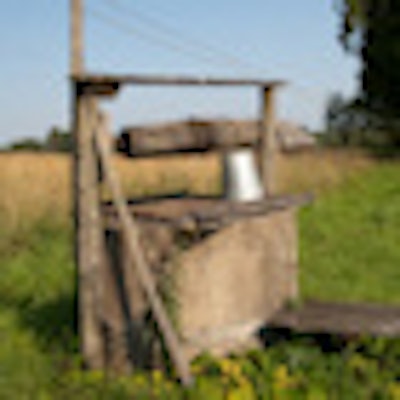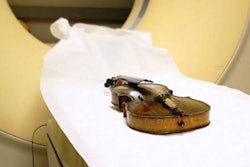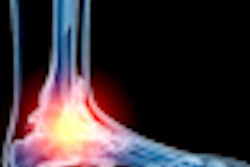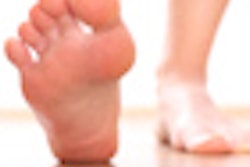
Austrian researchers are convinced that MRI has much to offer when it comes to dendrochronology, the scientific method of dating based on the analysis of patterns of tree rings. In archeology, the technique is used extensively to date old buildings and objects.
"MRI represents a noninvasive visualization methodology suitable for many aspects of the characterization of archeological wood finds in their wet state," noted lead author Dr. Andreas Berg, from the Center for Biomedical Physics and Biomedical Engineering at the Medical University of Vienna. "The MR appearance of ancient wet wood is varying strongly, dependent on wood species, sample size, and extraction point, and thus demands an extensive variety of MR hardware, pulse sequences, and MR protocols."
 MRI is proving an effective way of evaluating vintage wooden wells, according to Austrian researchers.
MRI is proving an effective way of evaluating vintage wooden wells, according to Austrian researchers.
High-resolution 3D-imaging based on CT has proved useful for characterizing archeological finds, including the annual ring (AR) structure in ancient wood, but CT fails when it comes to wet wood because of the missing x-ray absorption contrast. Therefore, he advocates the use of parameter-selective MR microimaging for the characterization of wet timber.
MR microimaging (ps ~ 200 µm x 200 µm) allows for the evaluation of ARs, although an even higher spatial resolution would be preferable for more accurate determination of the AR width (~1mm, dependent on the specific sample), Berg and his colleagues explained to delegates in an e-poster at last week's European Society of MR in Medicine and Biology (ESMRMB) congress in Lisbon. Using MR microscopy (ps < 100µm) on small samples, AR width can be determined at sufficient spatial resolution, but due to the small field-of-view, the number of detected ARs is limited in such cases. Consequently, the dating based on a minimum number of ARs might become difficult.
The growth of cambium cells in trees varies from season to season, resulting in a periodical microstructure characterized by large cells in spring and small cells in autumn and winter, they stated. The sequence of varying AR distance depends on local climate, including precipitation levels and temperature. This specificity of the AR pattern structure on the individual time period represents the basis for the dating of the corresponding archeological wood sample.
The group has studied wood specimens that originate from the middle bronze age (around 1500 BC), which was discovered in 2009 in Wohlsdorf, Styria, Austria.
"The investigated archeological wood planks and small specimen around served as fixation for the excavations of the well fountain," the researchers recalled. "The wood components were flushed by water support from aside up to the present. The archeological wet wood finds have to be kept wet, until active conservation (impregnation and freeze drying) can take place. This conservation method is a process of approximately two years duration."
The sample was characterized by two separate areas: a normal and a degraded part at the outside, most probably caused by fungi during the growth process 3,500 years ago. The demarcation line between the degraded parts and normal wood was characterized by tylosis, as proved by histological analysis.
The team uses different MR methodologies, ranging from ultrahigh-field (UHF) large-scale imaging to microscopic spatial resolution, and from T2 mapping at standard echo times of ms to ultrashort encoding time (UTE) imaging (TE = 70µs). In many cases, a T2-weighted sequence with multiple echoes offers good morphological results.
For MR microscopy, they use a custom-built strong microgradient insert capable of G = 750mT/m and a sensitive circular polarization birdcage resonator on a UHF 7-tesla human scanner. The hardware and concepts are based on research, and are not commercially available. The software is based on clinically available Syngo pulse sequences work in progress packages for UTE from Siemens Healthcare, with microimaging adapted protocols.
"The number of annual rings necessary for dendrochronological dating is dependent on several factors, mainly the accuracy of archeological reference data, available in the corresponding climate zone and the inter- and intrasample variation in the specific region," Berg noted. "As a rule of thumb about 30 annual rings should be available for crossdating. The small size of archeological samples might not cover this minimum number of annual rings dependent on the AR width of the specimen."
The sequence of varying distances (profile) between the ARs is indicative of climate conditions, and is specific to the climate region and time period. The MR data may allow for the cross-dating of the sample, if sufficient dendrochronological reference data from other wood specimen for this climate zone are available. The MR methodology and image data may also be used for building up a set of dendrochronological overlapping AR patterns as a reference table for future crossdating of other samples.
"MR microimaging and microscopy is capable of detecting regions of degradation and wood microstructure, allowing in many cases the identification of wood species, which is important within the conservation process of archeological wet wood. It may thus be in the future a valuable tool for the nondestructive characterization of unique wood samples and in principle even for dendrochronological dating," the authors concluded.
For further information about MR microscopy and microimaging, click here forthe home page of the Center for Biomedical Physics and Biomedical Engineering at the Medical University of Vienna. For a Wikipedia link on dendrochronology, click here. To read about the principles of dendochronology, click here.



















